Introduction
Algae are very important producers in the marine environment's food chain. Through photosynthesis, by using energy from sunlight, algae can convert carbon dioxide and important nutrient elements such as Carbon, Magnesium, Hydrogen, Oxygen, Potassium, Iodine, Nitrogen, Calcium and Iron into carbohydrates and proteins that sustain all animal life. Some very important examples of fossilized algae have been found in the Pennsylvanian and Permian strata of southeastern Nebraska and southwestern Iowa.
Algae are very important fossils in helping geologists and paleontologists to understand the ancient environments of depositions and ecosystems that existed in the geologic past. The kind of algae present in a rock can give the geologist some idea as to the depth of water in which the rock was deposited. Some wavelengths of light penetrate the water column deeper than other wavelengths. Different species of algae photosynthesize at different wavelengths of light. For example, red wavelengths of light penetrate deeper than blue wavelengths so a species of algae that used only red wavelengths would suggest it lived in deeper water.
All algae live in the photic zone---the range of water depths that sunlight penetrates and photosynthesis takes place. By using carbon dioxide, the algae produces the carbonate (CO3) ion which is one of the the building blocks of calcite (CaCO3), the mineral component of limestone.
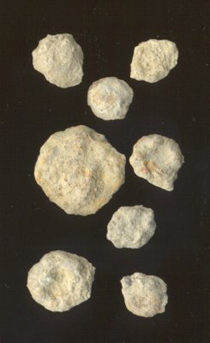
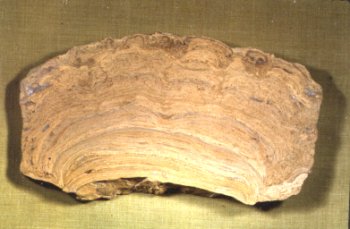
Stromatolites from the Ozawkie Limestone member, Deer Creek Formation, Cass County
Description: Fagerstrom and Burchett (1972) recorded large algae heads (stromatolites) from the Ozawkie Limestone Member of the Deer Creek Limestone Formation. They interpreted the stromatolites as having grown in a very shallow intertidal environment that existed along the shoreline of an ancient seaway. Fagerstrom and Burchett compared these fossil stromatolites to ones of recent origin that Logan (1961) described from Shark Bay in Western Australia. Logan showed that the heights of the stromatolites in Shark Bay were directly related to the depth of water between low tide and high tide. From Logan's observations, Fagerstrom and Burchett suggested that the tidal range during deposition of the Ozawkie Limestone was at least 8 inches, the maximum height of the stromatolites, in western Mills County, Iowa. Following a line that was approximately perpendicular to the ancient shoreline, Fagerstrom and Burchett showed the maximum height of the stromatolites decreased to 3 inches at the north end of King Hill Quarry to one inch at the south end of the quarry in estern Cass County, Nebraska. From these observations, they suggested that the paleoslope in the intertidal zone was less than two inches per mile.
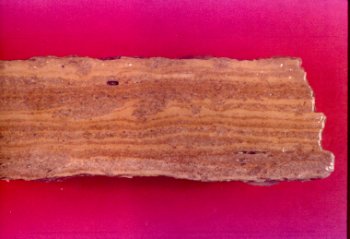
Cryptalgalaminae from the Salem Point Shale member, Grenola Formation, Richardson county
Description: Aitken (1967) defined and described cryptalgal limestone and dolomite from rocks of Cambrian and Ordovician ages in Alberta, Canada. Cryptalgalaminae differ from stromatolites inasmuch as the former are characterized by "?discontinuous, more or less planar laminations" and the latter are "?fixed bodies with non-planar laminations and definable boundaries or contacts with other stromatilites." The cryptalgalaminae seen here are from near the top of the Salem Point Shale member of the Grenola Formation of early Permian age exposed in Richardson County. Pabian and Diffendal (1991) showed that this bed was bioturbated
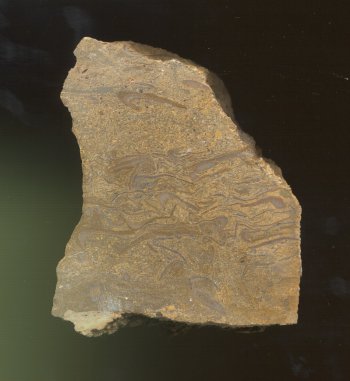
Phylloid Algae from the Reading Limestone member, Emporia Formation, Pawnee County
Description: Harbaugh (1959, 1962) recorded abundant sources of leaf-like or phylloid algae in rocks of late Pennsylvanian age in southeastern Kansas. The algal mounds that are well exposed in southeastern Kansas are well-known geologic sites that have been visited by geologists and paleontologists from around the world. The mounds in Kansas have grown to great thicknesses because they were situated near the edge of a deep basin from which upwelling currents brought up abundant nutrients to foster rapid algae growth. The structure of the algae mounds has been compared to pouring a resin over potato chips. Phylloid algae has been observed in many limestone beds in Nebraska but never in the amounts it has been observed in the Kansas outcrops.
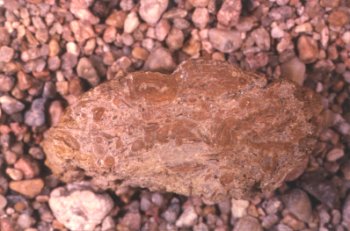
Oncolites from the White Cloud Shale Member, Scranton Formation, Pawne County
Description: Oncolites consist of a nucleus covered by successive layers of algae and silt or clay sediment. They form when a nuclesu such as a sand grain or fossil is covered by algae, buried in sediment, covered with sediment, exhumed, again covered with algae, buried, covered with sediment?..for many successive episodes. Thus, oncolites represent repeated episodes of sitturbances of sea floor (substrate) that is commonly observed in very near shore, shallow water environments. Pabian and Diffendal (1991) observed oncolites in many of the limestone bed in Pawnee and Richardson counties.

Oncolites from the Haynies Limestone bed, Ervine Creek Limestone member, Deer Creek formation, Cass County
Description: Cups of the late Pennsylvanian crinoids Apographiocrinus and Contocrinus are the nuclei for these oncolites from the Haynies Limestone bed in Cass County. LaGarry, Rudnick and Kirkland (1989) and LaGarry-Guyon, Rudnick, Moser and Holmes (1992) recorded abundant oncolites from the Haynies Limestone bed in Cass County.
References
- Aitken, J. G., 1967. Classification and environmental significance of cryptalgal limestones and dolomites, with illustrations from the Cambrian and Ordovician of south-western Alberta. Journal of Sedimentary Petrology, v. 37, p. 1163-1178.
- Fagerstrom, J. A., and Burchett, 1972. Upper Pennsylvanian Shoreline Deposits from Iowa and Nebraska: Their Recognition, Variation and Significance. Geological Society of America Bulletin, v. 83, p. 367-388.
- Harbaugh, J. W., 1959. Marine bank development in Plattsburg Limestone (Pennsylvanian), Neodesha-Fredonia area, Kansas. Kansas Geological Survey Bulletin 134, pt. 8, p. 289-331.
- Harbaugh, J. W., 1962. Geologic guide to Pennsylvanian marine banks, southeast Kansas. Kansas Geological Society, 27th Field Conference, Guidebook, p. 13-67.
- LaGarry, H. E., Rudnick, C. E., and Kirkland, J. I., 1989. Biostratigraphy, Paleoecology, and Storm Wave Disturbance in the Pennsylvanian-Aged "Haynies Limestone" Bed (Deer Creek Fm.) of Cass County, Nebraska. Nebraska Academy of Sciences, Proceedings, 99th Annual Meeting, April 14-15, 1989, Nebraska Wesleyan University, p. 52-53.
- LaGarry-Guyon, H. E., Rudnick, C. E., Moser, D. W., and Holmes, S. C.,1992. Geological Society of America, North-Central Section, 26th Annual Meeting, Abstracts with Programs, v. 24, no. 4, p.
- Logan, B. W., 1961. Cryptozoon and associated stromatolites from the Recent, Shark Bay, Western Australia. Journal of Geology, v. 69, p. 517-533.
- Pabian, R. K. and Diffendal, R. F. Jr., 1991. Late Paleozoic Cyclic Sedimentation in Southeastern Nebraska: A Field Guide. Conservation and Survey Division, IANR, University of Nebraska-Lincoln, Educational Circular No. 9, 64 p.
